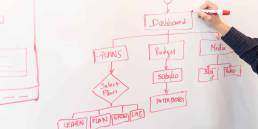It’s another Lean Startup summary. We’ve been reading the Lean Startup by Eric Ries for about 5 months, and so far, we’ve read ten chapters.
TLDR: Actionable Insights for entrepreneurs and business people:
- Break down complex operations or projects into simple tasks. It becomes easier to manage problems that arise during production or execution.
- Don’t waste time perfecting your product. Learn from customers and then improve your product.
- Happy customers equals more customers. Happy people like to talk about what makes them happy.
- There are three engines of growth: viral, paid and sticky. Eric Ries recommends that Startups focus on one of these at a time.
You can click on any of the following links to read our previous key lesson articles:
The Lean Startup Summary Part 3
The Lean Startup Summary Part 2
The Lean Startup Summary Part 1
The Lean Startup Chapter 9: Batch
“The biggest advantage of working in small batches is that quality problems can be identified much sooner.”
It is easier to identify issues when projects are broken down into smaller, manageable tasks. This leads to faster resolution and improvement, ultimately improving work quality. It’s also a customer-centric approach, in that building in small increments enables for faster reactions to client feedback. You can make modifications depending on what your customers actually want or need, improving your product-market fit.
“finding out sooner is much better than finding out later.”
“The ability to learn faster from customers is the essential competitive advantage that startups must possess.”
Startups must obtain feedback quickly, analyze data, and make appropriate changes to their business plans, goods, or services. The ability to learn from customers faster than competitors provides an edge. It’s not about shipping features frequently, but going through the build-measure-learn loop faster than your competition. In fact, startups can outperform larger, more established companies by simply being more receptive to client feedback.
The Lean Startup Chapter 10: Grow
“Sustainable growth is characterized by one simple rule: New customers come from the actions of past customers”
A business must constantly attract new clients in order to expand. The behaviours of previous consumers are crucial in gaining new clients.
According to Ries, “There are four primary ways customers drive sustainable growth:
- Word of mouth
- As a side effect of product usage
- Through funded advertising
- Through repeat purchases or use
Word of Mouth
When customers share positive reviews with others. This organic kind of marketing focuses on happy consumers becoming advocates.
As a Side Effect of Product Usage
Sometimes just using a product or service promotes the product. For example, when you share a funny video you find on TikTok with a friend, you are promoting TikTok.
Through Funded Advertising
That is, advertising and marketing to reach new clients, whether through traditional channels like billboards and radio or digital marketing.
Through Repeat Purchases or Use
Encouraging repeat purchases or more usage by running different promotional campaigns, frequently launching new product versions or adding more features customers find useful.
Engines of Growth
Chapter 10 also highlights Three engines of growth for Startups.
These are not mutually exclusive but the book advises startups to focus on one engine of growth at a time.
According to Eric Ries, “Engines of growth are designed to give start-ups a relatively small set of metrics on which to focus their energies.”
In the previous review, we discussed vanity metrics which are metrics that give a nice impression of your business without offering insights into its actual health. So, in the plethora of metrics to track, having a clear understanding of your engine of growth helps with selecting the right metrics for measurement.
The Sticky Engine of Growth
“This relies on having a high customer retention rate. The expectation is that once you start to use their product, you continue to do so.”
If your business uses this engine of growth, it means that your focus must be retaining existing consumers over time. If the rate of obtaining new customers exceeds the turnover rate, the product grows. Customer retention is more cost-effective than constantly obtaining new ones. The goal here would be for your customers to continue using the product after they have tried it. The more they utilize it, the more they gain from it and the more it becomes a part of their daily routine. For example, Instagram, TikTok, X, and Linkedin. Your product will grow if the rate at which new customers are gained outpaces the rate at which customers discontinue using the product (churn rate).
The Viral Engine of Growth
“Growth happens automatically as a side effect of customers using the product. Viruses are not optional”
The COVID-19 pandemic demonstrated that viruses can spread quickly and indiscriminately. Similarly, successful products, once they establish a footing, can spread quickly among consumers due to their intrinsic attraction and value.
According to Ries, “The viral engine is driven by a quantifiable feedback loop called the viral loop whose speed depends on a mathematical term called the viral coefficient. So, the greater this coefficient, the faster the product spreads. The viral coefficient calculates how many new consumers will use a product as a result of each new sign-up. That is, how many friends will each customer bring?”
“Companies that rely on the viral engine of growth must focus on increasing the viral coefficient more than anything else because even tiny changes in this number will cause dramatic changes in their future prospects”
Social media is a also good example here. We all agree that the strength of any social platform is the number of active users. So, it’s important to design the product or service in such a way that it gains value as more people use it. This can result in a network effect, in which the value of the product increases with each new user, driving existing customers to refer additional people. Moreover, these platforms thrive on data optimization. They constantly analyze our activities while on these platforms and suggest more content that we will find useful or that would keep us engaged.
The Paid Engine of Growth
This growth engine focuses on customer acquisition via paid marketing and advertising. According to Ries, the paid engine of growth entails investing money to attract clients. This can include things like Google Ads, social media advertising, influencer collaborations, or having a sales team.
The effectiveness of this growth engine is strongly dependent on the cost of gaining consumers in comparison to their lifetime value (LTV). Companies must ensure that the cost of obtaining a customer is justified by the income generated by that customer throughout their engagement with the company. So for example, a software as a Service company (SaaS) sells enterprise licenses to large organizations.
I found this last point very interesting and unexpected, so apparently, according to the Lean Startup;
“Every engine of growth is tied to a set of customers and their related habits, preferences, advertising channels, and interconnections. At some point, that set of customers will be exhausted. This may take a long time or a short time, depending on one’s industry and timing.”
The next chapter (chapter 11) explains this in detail. I’ll have to understand this first and I can expatiate in the next review.
Olutobi
I write about business and project management.
10+ years working in program management. I've worked in health-tech, community health, regulatory affairs and quality assurance.


